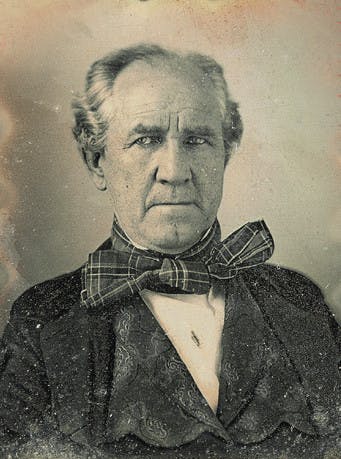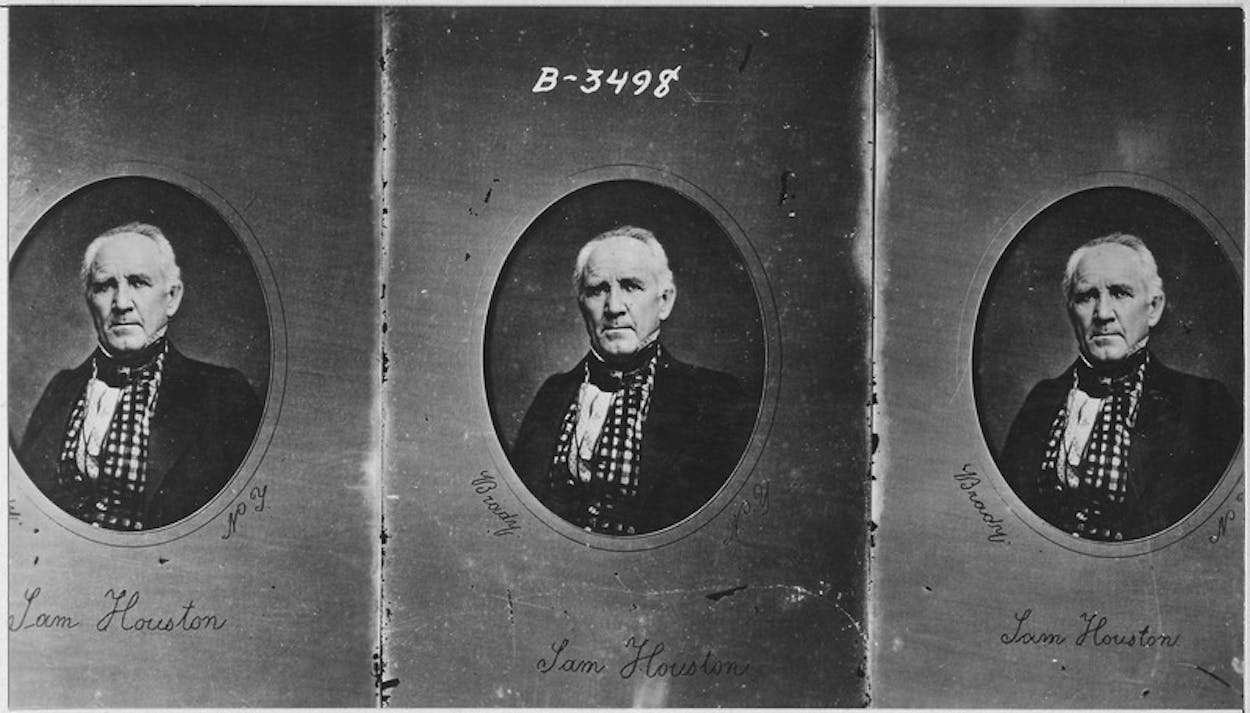By most accounts, Sam Houston and Texas were both born on the same date: March 2. (There is a little disagreement among historians on when the Texas Declaration of Independence was ratified by all signers.) And despite what you might have read, according to Houston biographer James L. Haley, “What’s not true is that Houston made them wait until his birthday to sign the declaration. If he’d thought about it, he probably would’ve.”
Be that as it may, what better time to share a few lesser known anecdotes and insights into perhaps the most eccentric, headstrong, and wonderful leaders this great state has ever known?
Houston loved to make statements with his attire
Often it was retro. When it came time to hand over the reins of Texas to his arch-nemesis, president-elect Mirabeau B. Lamar, Houston decked himself out in vintage threads in an effort to mimic Gilbert Stuart’s portrait of President George Washington. According to Haley:
“Houston arrived dressed like George Washington, in a suit of federal knee-breeches and his hair tied in a queue. According to one observer, the departing president “dressed himself so much like Stuart’s portrait…with powdered hair and elegant fitting garments, that he really looked more like the picture than ever Washington did himself.”
Decked out in this vintage gear, and perhaps with a gourd or two of rye whiskey aboard, Houston proceeded to give an passive aggressive three- or four-hour farewell address, as the eager Lamar seethed, simmered, and finally boiled over. By the time Houston left the stage, Lamar was so infuriated, his secretary had to read his speech for him.
Then there was the time Houston reached even farther back in time, commissioning a portrait of himself as Roman hero Gaius Marius. And like those hipsters you see at festivals rocking Native American headdresses, Houston loved to deck himself out, sometimes even appearing at official government meetings in full Cherokee attire, much to the disgust of lames like then-secretary of war John C. Calhoun.
Unlike the modern hipsters whose trail he blazed, Houston earned that right. He lived amongst the Cherokee on multiple occasions, had been adopted into the tribe, and fought (with little success, in the end) to preserve their rights. You could say he had a pass, unlike those cultural-appropriating kids at Coachella. And while with the Cherokee, Houston picked up the habit of whittling, make him a craftsy artisan.
One last note on his fashion sense. When modern hipsters wear neckties, they tend to be ridiculous. The same went for Houston.

Francis Scott Key represented him in court
And then there was the time that Francis Scott Key, yes, that Baltimore attorney who wrote the lyrics to the national anthem, ineffectually represented Houston in a very important case.
Houston had beat, caned, and called Ohio congressman William Stanbery a “damned rascal” on Pennsylvania Avenue in Washington, an incident that arose after Stanbery had publicly claimed that during his term as Tennessee governor, Houston had swindled his beloved Cherokee Indians.
Hauled before Congress to answer for his alleged crime, Houston delivered his own closing argument, reportedly because Key was “indisposed” (read: hungover) at the trial. (Some reports have it that Houston was equally “indisposed,” but better able to marshal his thoughts from the defense bar.) Though Houston was quite persuasive in protection of his own honor—one woman in the gallery said “I had rather be Sam Houston in a dungeon than William Stanbery on a throne”—he was convicted, though he never paid a dime nor served a day behind bars for his offense. He hightailed it for Texas before the law could lay a finger on him.
He had a huge fear of ticks
Houston was famously a drinker, at least for the first half of his life before his marriage to Margaret Lea. Haley, author of 2004’s Sam Houston, pointed out his favorite boozy Houston tale to Texas Monthly, which involved Houston, wine, and ticks.
At the time, the divorced Houston was courting Anna Raguet of what is now the Lufkin/Nacogdoches area. She would spurn his advances, thanks in no small part to antics like the following, as related in Haley’s book:
“[Of] Houston’s many sojourns in Nacogdoches, this was to be the most stressful, because with everything else going wrong, he still had to be on his best behavior in his losing campaign for the affections of Anna Raguet. This particular stay, therefore, is most likely the one during which Houston accompanied several lawyer friends on a hunting excursion of several days on Neal Martin’s property outside of town. While the other men were in pursuit of the panting deer, Houston, attended by his bodyservant, also named Sam, stayed behind at Martin’s cabin, drinking, or as the bodyservant put it, the president “looked upon the wine when it was red.” This got to annoy his companions, who determined upon an appropriate revenge:
The general had a horror of ticks; he would strip off his clothes and make Sam tick him every night before he went to bed. One day his legal friends, assisted by Martin’s children, picked a cap box full of ticks—deer ticks, dog ticks, seed ticks, every other kind of tick. There must have been a million of them in that box. That night, just as General Houston was getting into his bed, one of his friends surreptitiously emptied the box of ticks into his bed. Exclamation points are needed here !!! He called for SAM in capital letters. The reader may conjure his most expressive language . . . and it won’t begin to do justice to General Houston’s vocabulary. He himself had to resort to the [Cherokee] tongue.”
He had an ego
Though he always pulled for the underdog, Houston was a titanic egotist, a person modern-day therapists might brand a “positive narcissist.” University of Houston Texas history professor Stanley Siegel loved to point how Houston’s signature looked as much like “I am Houston” as it did “Sam Houston.” I ran Siegel’s theory by Haley and he said it’s been much noted over the years.
“I have seen his signature on documents where you would sweat that ‘S’ really looks like and ‘I,’ and he was aware that the kings of Spain would sign documents ‘Yo el Rey’’: ‘I, the King.’ Not like Queen Elizabeth who signs documents Elizabeth R; the king of Spain signs, I the King. I think it’s true.” Haley adds that this belief was disputed by Houston’s recently-deceased great-granddaughter Madge Roberts, family doyenne and historian. “She didn’t think it was true and I never would have contradicted her to her face, but it’s just too good not to be true.” Just as Houston himself was.







